All located within a 7-hour drive, these 13 Stunning National Parks near Las Vegas (plus 7 more State Parks, National Monuments, and National Recreation Areas) are the perfect place to escape the hustle of Sin City.
If you are looking to escape into nature from the hubbub of Las Vegas Nevada, then we have you covered! Located just a short drive from the glitz and glamour of the Las Vegas Strip you’ll find a treasure trove of breathtaking landscapes and outdoor adventures waiting to be explored.
In this post, we’ve compiled a list of 13 incredible National Parks near Las Vegas, accompanied by 7 State Parks, National Recreation Areas, and National Monuments, all within a convenient 7-hour drive from the neon-lit heart of Sin City.
Prepare to embark on a scenic odyssey as we guide you through each park, listed in order of driving distance from Las Vegas. Alongside each destination, we provide the distance in miles and the estimated time it takes to journey there by car, offering you a comprehensive roadmap to some of the most spectacular natural wonders the American Southwest has to offer.
From rugged canyons to serene desert oases, the diversity of landscapes within reach of Las Vegas is bound to captivate and inspire outdoor enthusiasts and nature lovers alike, or simply make for the perfect place to stop on your American road trip as you head out to discover more of this amazing country.
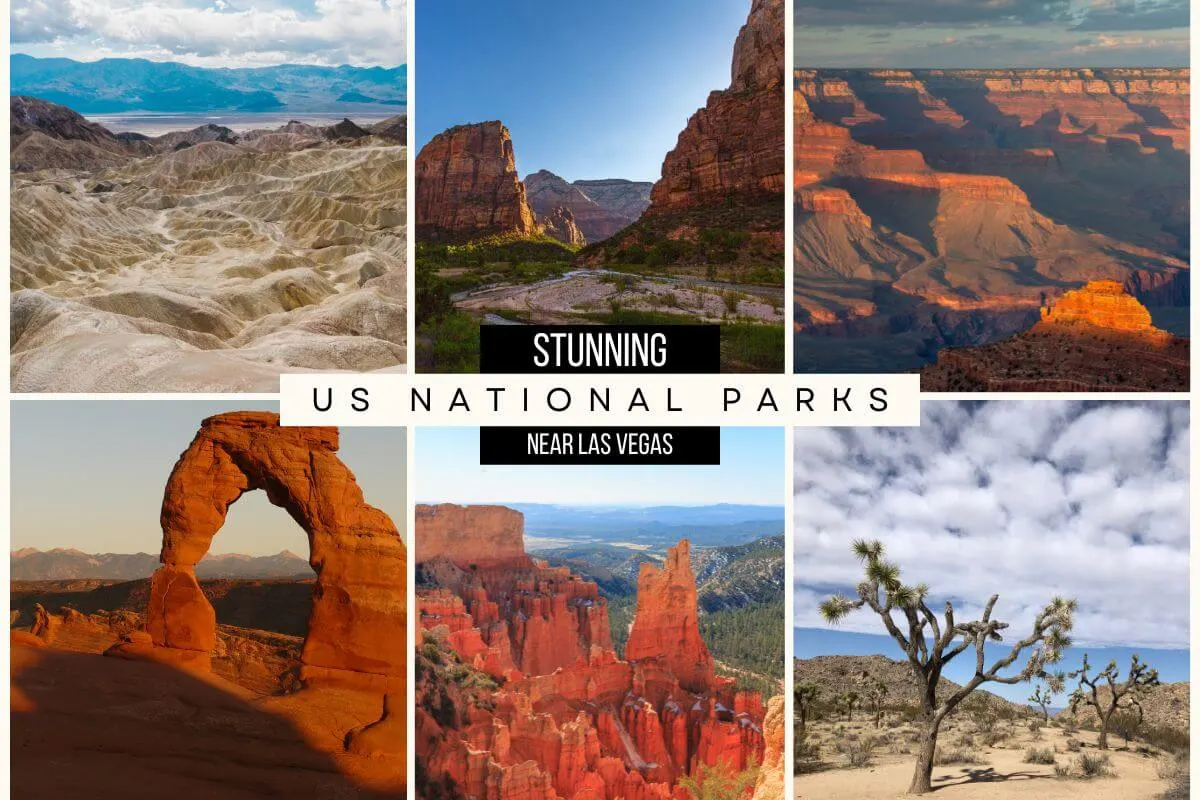 Disclaimer: Almost all posts on this site contain affiliate links, and this one featuring 13 National Parks near Las Vegas is no different. This means that if you click on any of the links in this post (and make a purchase) I may receive a small commission at absolutely no cost to you. Each post is carefully crafted to (hopefully!) answer all your questions and recommendations are made where we believe they will improve your trip and help with your planning. As such we thank you in advance should you decide to click & buy. Read my full Disclosure here.
Disclaimer: Almost all posts on this site contain affiliate links, and this one featuring 13 National Parks near Las Vegas is no different. This means that if you click on any of the links in this post (and make a purchase) I may receive a small commission at absolutely no cost to you. Each post is carefully crafted to (hopefully!) answer all your questions and recommendations are made where we believe they will improve your trip and help with your planning. As such we thank you in advance should you decide to click & buy. Read my full Disclosure here.
In This Post
- 1 National Parks Near Las Vegas Map
- 2 13 National Parks Near Las Vegas Nevada (in order of driving distance)
- 2.1 Death Valley National Park (California) – 2hr 22 mins | 126 miles
- 2.2 Zion National Park (Utah) – 2hr 24 mins | 156 miles
- 2.3 Joshua Tree National Park (California) – 3hr 53 mins | 187 miles
- 2.4 Bryce Canyon National Park (Utah) – 4hrs 8 mins | 264 miles
- 2.5 Grand Canyon National Park (Arizona) – Between 2.25 hrs – 5.75hrs | 126 – 281 Miles
- 2.6 Great Basin National Park (Nevada) – 4hr 56 mins | 309 miles
- 2.7 Capitol Reef National Park (Utah) – 5hr 21 mins | 338 miles
- 2.8 Petrified Forest National Park (Arizona) – 5hr 36 mins | 369 miles
- 2.9 Sequoia National Park (California) – 6hrs | 375 miles
- 2.10 Kings Canyon National Park (California) – 6hrs 42 mins | 411 miles
- 2.11 Arches National Park (Utah) – 6hr 48 mins | 458 miles
- 2.12 Canyonlands National Park (Utah) – 7hrs | 470 miles
- 2.13 Yosemite National Park (California) – 7hrs 15 mins | 451 miles
- 2.14
- 3 National Monuments, National Recreation Areas & State Parks Near Las Vegas
- 3.1 Old Las Vegas Mormon Fort State Historic Park – 22 mins | 7 miles
- 3.2 Red Rock Canyon National Recreation Area (Nevada) – 28 mins | 15 miles
- 3.3 Hoover Dam & Lake Mead Recreation Area (Nevada) – 42 mins | 30 miles
- 3.4 Valley of Fire State Park (Nevada) – 55 mins | 55 miles
- 3.5 Mojave National Preserve – 1hr 3 mins | 68 miles
- 3.6 Antelope Canyon & Horseshoe Bend (Najavo Nation – Arizona) – 4hr 30 mins | 280 miles
- 3.7 Monument Valley Navajo Tribal Park (Najavo Nation, Utah-Arizona Border) – 6hr 23 mins | 399 Miles
National Parks Near Las Vegas Map
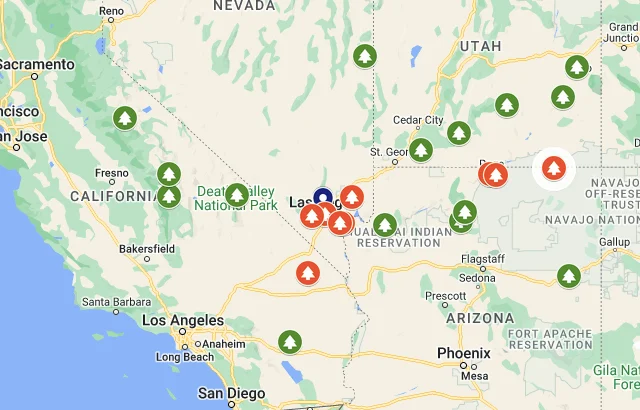 This map of the 13 United States National Parks near Las Vegas (Green), plus 7 State Parks, National Monuments, National Conservation Areas, and National Preserves near Las Vegas (Orange), is color-coded. Click the map itself or here to open it in another window where you can zoom in and out between parks and obtain driving directions between each.
This map of the 13 United States National Parks near Las Vegas (Green), plus 7 State Parks, National Monuments, National Conservation Areas, and National Preserves near Las Vegas (Orange), is color-coded. Click the map itself or here to open it in another window where you can zoom in and out between parks and obtain driving directions between each.
– Get the Best of Sin City! Things to do, where to stay and where to eat!
– Where to stay in Las Vegas (whatever your budget),
– TOP 40+ FREE Things to do in Las Vegas
– Best Things to do in Downtown Las Vegas
– Road Trips from Las Vegas
– Best Things to do in Downtown Las Vegas &
– Las Vegas Tip to Know Before You Go
13 National Parks Near Las Vegas Nevada (in order of driving distance)
Note: We’ve calculated all driving distances and estimated drive times from the Bellagio Hotel & Casino, as a central point on the Las Vegas Strip.
Death Valley National Park (California) – 2hr 22 mins | 126 miles
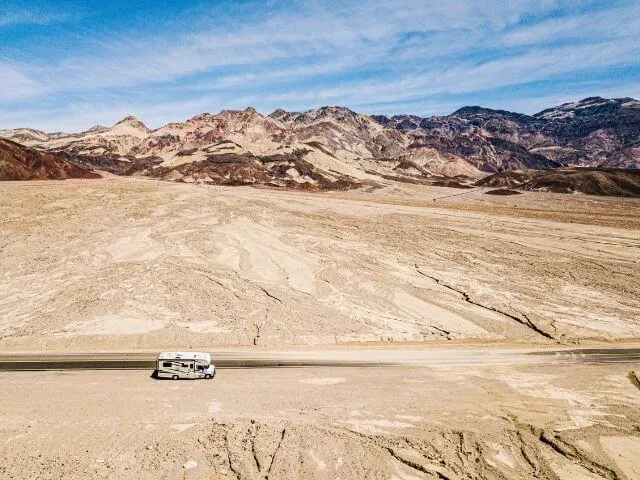 Note: Death Valley also crosses into Nevada.
Note: Death Valley also crosses into Nevada.
Driving Distance from Las Vegas: 126 miles (approx 2hr 22 mins)
Year Established: 1994
Annual Visitors: 1.7 million
Best Time to Visit: November to March
Death Valley National Park Highlights: See Ubehebe Crater, visit Badwater Basin, Hike Mesquite Flat Sand Dunes at sunset, See Zabriskie Point at sunrise & stargaze.
Death Valley National Park is a unique and diverse destination located in the Mojave Desert in California. The park is known for its vast and unforgiving landscapes, including the lowest point in North America, Badwater Basin, and the hottest place in the world, Furnace Creek.
Visitors can explore the park through hiking, camping, and scenic drives, and should be aware that temperatures can reach extreme levels during the summer months, making it best to visit during the cooler months of fall, winter, and spring.
The park also offers a variety of other experiences, from visiting the historic mining town of Rhyolite to seeing the famous rock formations of Artist’s Drive and Zabriskie Point. Visitors should also be aware that the park is incredibly vast and remote, and it is important to come prepared with enough water and supplies.
Zion National Park (Utah) – 2hr 24 mins | 156 miles
 Driving Distance from Las Vegas: 156 miles (approx 2hr 24 mins)
Driving Distance from Las Vegas: 156 miles (approx 2hr 24 mins)
Year Established: 1919
Annual Visitors: 4.5 million
Best Time to Visit: April to October
Zion National Park Highlights Hike The Narrows, Hike Angels Landing, Visit the Emerald Pools and Weeping Rock, Drive Zion Canyon Scenic Drive.
Zion National Park is located in the southwestern United States in the state of Utah. The park is known for its spectacular sandstone cliffs and canyons, which have been carved over millions of years by the Virgin River and its tributaries.
The park’s history dates back to the early 20th century, when it was established as Mukuntuweap National Monument in 1909. The park was later renamed Zion National Park in 1919 and has since been a popular destination for hikers, campers, and nature enthusiasts.
One of the park’s main highlights is the Narrows, a 16-mile hike through a narrow canyon with towering walls on either side. Other popular activities include hiking the Angels Landing trail, which offers breathtaking views of the valley below, and exploring the Kolob Canyons section of the park, which features red rock cliffs and unique rock formations. For more, read our guide to the Best Things to do in Zion (perfect for 1st timers!)
The best time to visit Zion National Park is during the spring and fall, when the weather is mild and the crowds are less. During the summer, temperatures can reach over 100 degrees Fahrenheit, and the park can get crowded. In the winter, some of the park’s trails may be closed due to snow and ice.
Joshua Tree National Park (California) – 3hr 53 mins | 187 miles
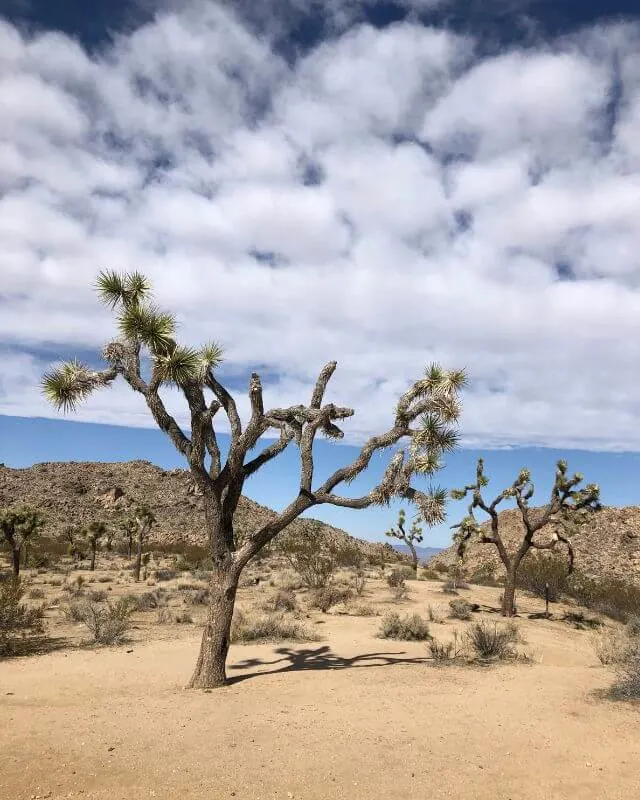 Driving Distance from Las Vegas: 187 miles (approx 3hr 53 mins)
Driving Distance from Las Vegas: 187 miles (approx 3hr 53 mins)
Year Established: 1994
Annual Visitors: 3.0 million
Best Time to Visit: March to April, October to November
Joshua Tree National Park Highlights: Sunrise at the Cholla Cactus Garden, See Skull Rock, Drive to Keys View and Geology Tour Road, and Hike Ryan Mountain.
Joshua Tree National Park is a desert park located in southern California, known for its stunning rock formations and dense forests of Joshua Trees. Visitors can enjoy hiking, camping, and rock climbing in the park.
Spring and fall are the best seasons to visit, as temperatures are milder and wildflowers are in bloom. When planning a trip, it is important to bring plenty of water and protect yourself from the sun, as temperatures can reach over 100 degrees Fahrenheit during the summer months.
Additionally, it is important to note that some areas of the park may be closed due to preservation efforts, so it is a good idea to check the park’s website before visiting.
Bryce Canyon National Park (Utah) – 4hrs 8 mins | 264 miles
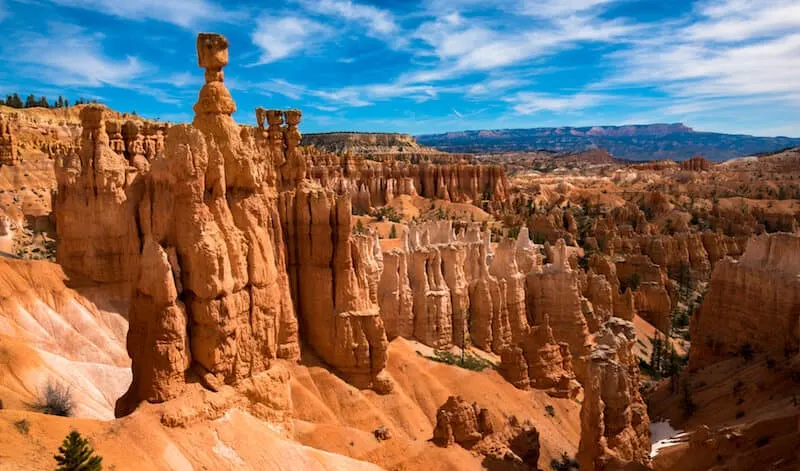 Driving Distance from Las Vegas: 264 miles (approx 4hr 8 mins)
Driving Distance from Las Vegas: 264 miles (approx 4hr 8 mins)
Year Established: 1928
Annual Visitors: 2.6 million
Best Time to Visit: April to October
Bryce Canyon National Park Highlights: See sunrise along the Rim Trail, Drive the Scenic Drive and stop at all the viewpoints (Sunrise Point, Sunset Point, Bryce Point and Inspiration Point etc), Hike Navajo and Queen’s Garden Loop.
Bryce Canyon National Park is located in southern Utah and is known for its unique and vibrant orange and red rock formations called hoodoos.
The park’s main feature is the Bryce Amphitheater, a natural amphitheater created by erosion that contains thousands of hoodoos. Visitors can hike along the rim of the amphitheater to get a panoramic view of the hoodoos and the surrounding landscape, or hike down into the amphitheater for a closer look.
Other popular activities include horseback riding, stargazing, and camping.
The best time to visit Bryce Canyon National Park is from April to October when the weather is mild and the park’s facilities and road are open. During the summer months, the park offers ranger-led tours and campfire programs.
The park also offers a shuttle service to take visitors to the different viewpoints and trailheads during the peak season to reduce traffic and parking congestion. Spring and fall are also ideal for visiting the park as the weather is milder and the crowds are smaller.
Grand Canyon National Park (Arizona) – Between 2.25 hrs – 5.75hrs | 126 – 281 Miles
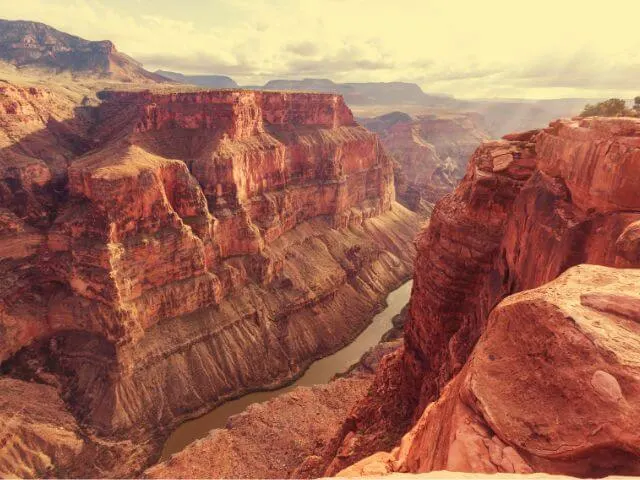 Driving Distance from Las Vegas:
Driving Distance from Las Vegas:
– South Rim: 281 miles (approx 4hr 30 mins)
– North Rim: 264 miles (approx 5hr 44 mins)
– Grand Canyon West 126 miles (approx 2hr 14 mins) – while not technically part of Grand Canyon National Park, the Hualapai Native Indian-owned reserve does lie in the Grand Canyon (and features the impressive Skywalk).
Year Established: 1919
Size: 1.2 million acres
Annual Visitors: 6.0 million
Best Time to Visit: March to May, September to October
Grand Canyon National Park Highlights: Hike South Kaibab, Hike Rim-to-Rim Trail, Visit South Rim viewpoints, Hike Bright Angel, Drive Hermit Road, take a flightseeing helicopter tour.
Grand Canyon National Park is located in northern Arizona and is home to the iconic Grand Canyon, a vast chasm that stretches over 277 miles long, up to 18 miles wide and over a mile deep. The canyon is considered one of the natural wonders of the world and is a UNESCO World Heritage Site. The park is also home to a diverse array of plants and animals, including the endangered California condor, bighorn sheep, and elk.
The park is popular with visitors who are interested in hiking, camping, and sightseeing. Visitors can hike to the bottom of the canyon along the Bright Angel or South Kaibab trails, take a scenic drive along Desert View Drive, or take a guided tour by mule. Visitors can also take a helicopter or plane tour to get an aerial view of the canyon.
The best time to visit the Grand Canyon National Park is between September and November, or March and May. During these months, the weather is mild, the crowds are thinner, and the fall foliage and spring wildflowers provide a colorful backdrop. Visitors should be aware that the park is incredibly busy in the summer months and it is recommended that visitors plan ahead to reserve campsites and tours in advance.
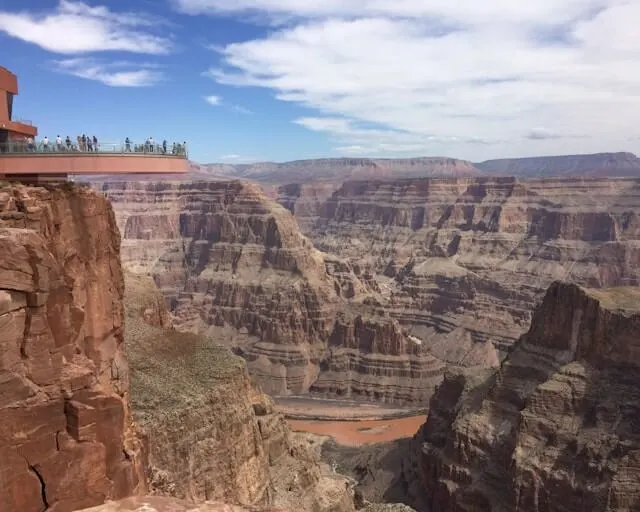 Note: As mentioned above, Grand Canyon West is not actually part of the Grand Canyon National Park, but it does sit geographically within the Grand Canyon.
Note: As mentioned above, Grand Canyon West is not actually part of the Grand Canyon National Park, but it does sit geographically within the Grand Canyon.
As it is run by the Hualapai Native American Indian Tribe, it has a very different feel to the National Park – in line with not being maintained or managed by the National Park Service, along with a different background and history.
It does however have a few advantages over the North and West rim. Firstly – and for those wanting to visit the Grand Canyon on a day trip from Las Vegas – is the shorter driving distance. This makes it really easy to combine with a trip to the Hoover Dam or Lake Mead Recreational Area (more on those below).
It is also home to the very impressive Skywalk – a horseshoe-shaped cantilever bridge with a glass walkway at Eagle Point, extending 70ft out above the Colorado River flowing 4000 ft below.
Great Basin National Park (Nevada) – 4hr 56 mins | 309 miles
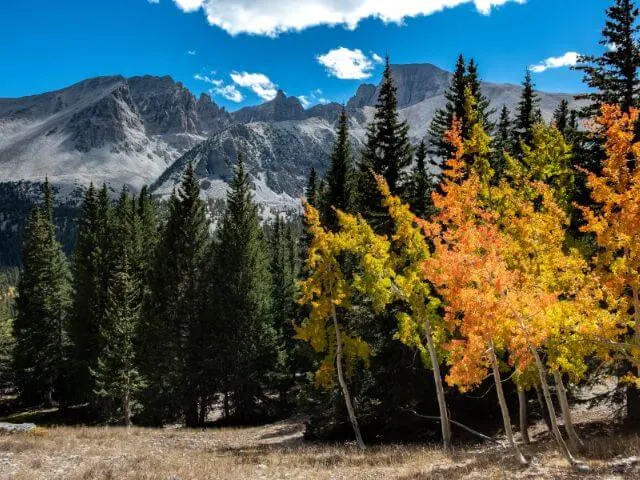 Driving Distance from Las Vegas: 309 miles (approx 4hr 56 mins)
Driving Distance from Las Vegas: 309 miles (approx 4hr 56 mins)
Year Established: 1986
Annual Visitors: 130,000
Best Time to Visit: April to October
Great Basin National Park Highlights: Hike Bristlecone Trail and the Alpine Loop Trail, Drive Wheeler Peak Scenic Drive, Go Stargazing, and Tour Lehman Caves.
Great Basin National Park is known for its beautiful landscapes and diverse array of plant and animal life.
The park’s centerpiece is the 13,063-foot-tall Wheeler Peak, which is the second-highest peak in Nevada. Visitors to the park can hike to the top of the peak, which offers stunning views of the surrounding mountains and valleys. The park also offers a variety of other outdoor activities such as camping, picnicking, and bird watching.
The best time to visit Great Basin National Park is during the summer months, when the weather is mild and the park’s wildflowers are in full bloom. Fall is also a great time to visit, as the aspens and cottonwoods turn golden yellow.
Winter can be very cold and snowy, but it’s also a great time for cross-country skiing and snowshoeing. Visitors should be aware that many of the park’s trails and roads are not maintained during the winter months, so proper planning and equipment are essential.
Capitol Reef National Park (Utah) – 5hr 21 mins | 338 miles
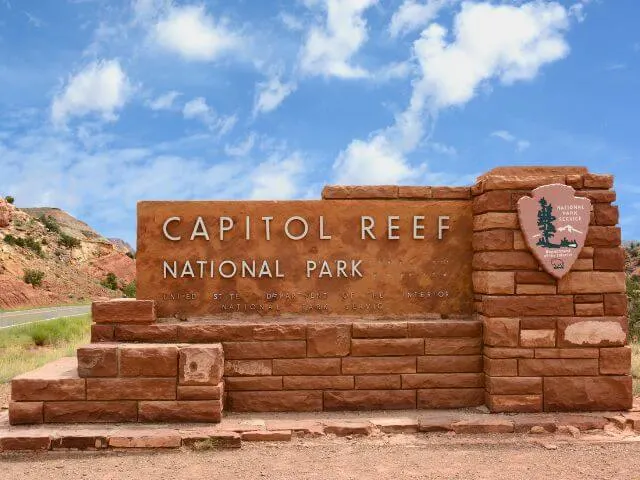 Driving Distance from Las Vegas: 338 miles (approx 5hr 21 mins)
Driving Distance from Las Vegas: 338 miles (approx 5hr 21 mins)
Year Established: 1971
Annual Visitors: 1.2 million
Best Time to Visit: March to May, September to November
Capitol Reef National Park Highlights: Hike Cohab Canyon and Cassidy Arch, Drive Capitol Gorge Road & The Scenic Drive
Capitol Reef National Park is located in south-central Utah and was established as a national park in 1971.
The park is known for its colorful sandstone cliffs and rugged landscape, as well as its historic orchards and pioneer settlements. The park’s main feature is the Waterpocket Fold, a 100-mile long wrinkle in the Earth’s crust that has created a unique landscape of cliffs, canyons, and domes.
The park offers a variety of activities for visitors including hiking, backpacking, and rock climbing.
The park’s scenic drive, the Capitol Reef Scenic Drive, offers visitors a chance to see the park’s main features, and the park has many hiking trails for visitors to explore.
The best time to visit Capitol Reef National Park is during the spring and fall when temperatures are mild and the crowds are smaller. Summer can be quite hot and the park can be quite crowded during the peak tourist season.
Petrified Forest National Park (Arizona) – 5hr 36 mins | 369 miles
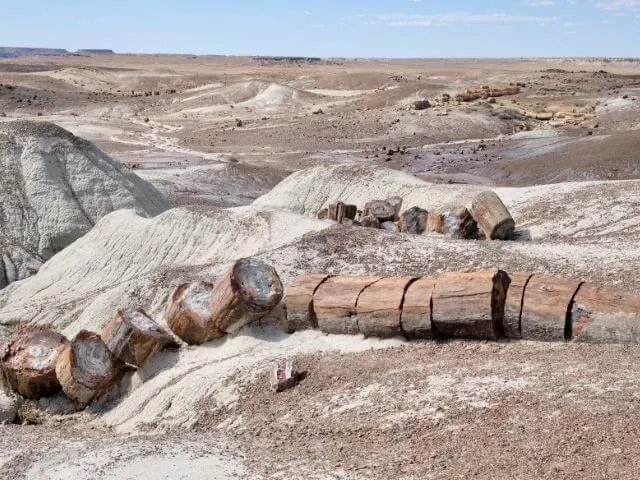 Driving Distance from Las Vegas: 369 miles (approx 5hr 36 mins)
Driving Distance from Las Vegas: 369 miles (approx 5hr 36 mins)
Year Established: 1962
Annual Visitors: 640,000
Best Time to Visit: Late March to May and September to October.
Petrified Forest National Park Highlights: Tour Puerco Pueblo, See the Painted Desert and Blue Mesa, Hike Agate House, and see the petrified wood at Crystal Forest and on the Giant Logs Trail.
Petrified Forest National Park is located in northeastern Arizona and is known for its vast and colorful petrified wood, ancient fossils, and unique desert landscapes. The park’s most famous feature is the “Painted Desert”, a region of badlands that stretches for miles and features colorful rock layers of red, orange, and purple. The park also contains one of the largest and most colorful concentrations of petrified wood in the world, as well as ancient fossils of plants and animals that lived in the area over 225 million years ago.
Visitors to Petrified Forest National Park can explore the park’s many hiking trails, take a scenic drive along the park’s paved road, or visit the park’s two main visitor centers, which offer exhibits and educational programs. The park also offers guided ranger walks and talks, as well as backcountry hiking and camping opportunities.
The best time to visit Petrified Forest National Park is during the spring and fall, when the weather is mild and the crowds are thinner. The park’s colorful landscapes and rock formations are particularly beautiful during the spring and fall. Visitors should be aware that summer temperatures in the park can be extremely hot, and it is recommended that visitors plan ahead to reserve campsites and tours in advance.
Sequoia National Park (California) – 6hrs | 375 miles
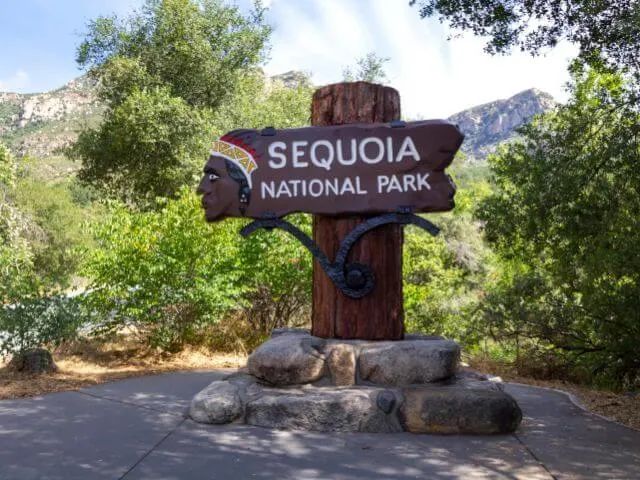 Driving Distance from Las Vegas: 375 miles (approx 6hrs)
Driving Distance from Las Vegas: 375 miles (approx 6hrs)
Year Established: 1890
Annual Visitors: 1.3 million
Best Time to Visit: June to October
Sequoia National Park Highlights: Drive under Tunnel Log, Hike Big Trees Trail and Moro Rock, and See the General Sherman tree.
Sequoia National Park is located in California’s southern Sierra Nevada mountain range. The park is known for its giant sequoia trees, which are some of the largest and oldest living organisms on Earth. The park’s most famous tree, the General Sherman Tree, is considered the largest tree in the world by volume. The park also boasts impressive granite cliffs, deep canyons, and a variety of wildlife.
The best time to visit Sequoia National Park is during the spring and fall seasons. During these times, the weather is mild and the crowds are less. Summer can get very hot, and winter can bring heavy snowfall, making some areas of the park inaccessible. Visitors should also be aware that some of the park’s main roads and trails may close during the winter season. At the opposite end of the spectrum, the park can get quite busy during summer weekends, so try to plan your visit during the week to avoid the crowds.
Kings Canyon National Park (California) – 6hrs 42 mins | 411 miles
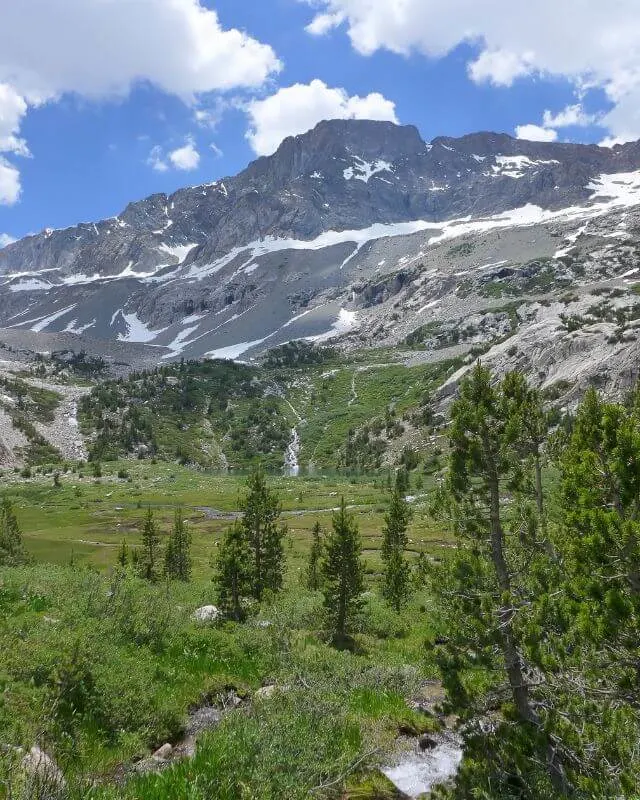 Driving Distance from Las Vegas: 411 miles (approx 6hr 42 mins)
Driving Distance from Las Vegas: 411 miles (approx 6hr 42 mins)
Year Established: 1940
Annual Visitors: 630,000
Best Time to Visit: June to October
Kings Canyon National Park Highlights: Hike Zumwalt Meadows, Backpack Rae Lakes Loop, Visit Grant Grove and Drive Kings Canyon Scenic Byway.
Kings Canyon National Park is located in the southern Sierra Nevada mountain range in California. The park is known for its deep canyons, towering granite cliffs, and towering sequoia trees. The park’s main attraction is the General Grant Tree, which is the second-largest tree in the world and is often referred to as the “Nation’s Christmas Tree.” The park also features the spectacular Kings Canyon, which is over a mile deep and is one of the deepest canyons in North America.
The best time to visit Kings Canyon National Park is during the summer months, from June to September. During this time, the weather is warm and sunny, and the roads and trails are clear.
The park is also open year-round, but some of the higher elevations may be snow-covered during the winter months. Visitors should be prepared for varying weather conditions, and be aware of the park’s rules and regulations regarding camping, hiking and backpacking. It’s also recommended to bring plenty of water and be aware of the park’s bear safety guidelines.
Arches National Park (Utah) – 6hr 48 mins | 458 miles
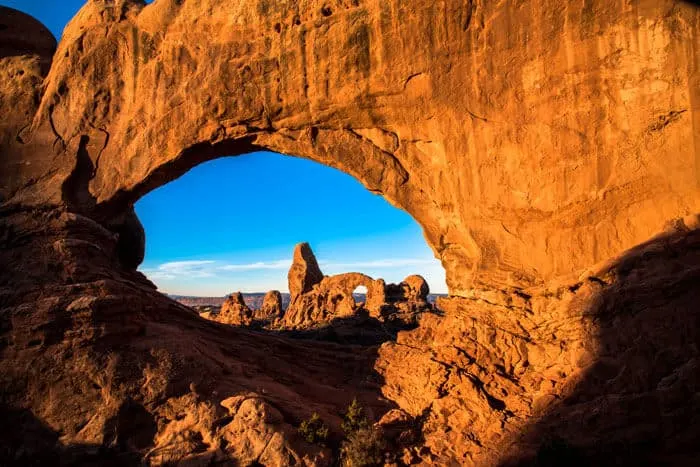 Driving Distance from Las Vegas: 458 miles (approx 6hr 48 mins)
Driving Distance from Las Vegas: 458 miles (approx 6hr 48 mins)
Year Established: 1971
Annual Visitors: 1.7 million
Best Time to Visit: March to May, September to November
Arches National Park Highlights: Hike Delicate Arch for sunset, visit the Double Arch, see Balanced Rock and the Fiery Furnace & Hike Windows Loop (Read all about the best Hikes in Arches NP here!)
Arches National Park is located in northeastern Utah, and is known for its over 2,000 natural sandstone arches that are spread throughout the park. The park’s red rock formations, canyons, and arches offer visitors a glimpse into the natural beauty of the American Southwest.
The park’s most famous arch, Delicate Arch, is a must-see. The arch is visible from a viewpoint accessible by a moderate 3-mile round-trip hike. The Park Avenue area, which features a 2-mile round-trip hike, is also a popular spot, offering visitors a chance to see towering red rock fins and other unique rock formations.
The best time to visit Arches National Park is during the spring and fall, when temperatures are mild and the park is less crowded. During the summer, the park can get very hot, and the park’s trails can be quite strenuous in the heat.
In the winter, the park is open but some of the roads and trails may be closed due to snow and ice. Overall, the park is open year-round, but the best time to visit is during the spring and fall.
Canyonlands National Park (Utah) – 7hrs | 470 miles
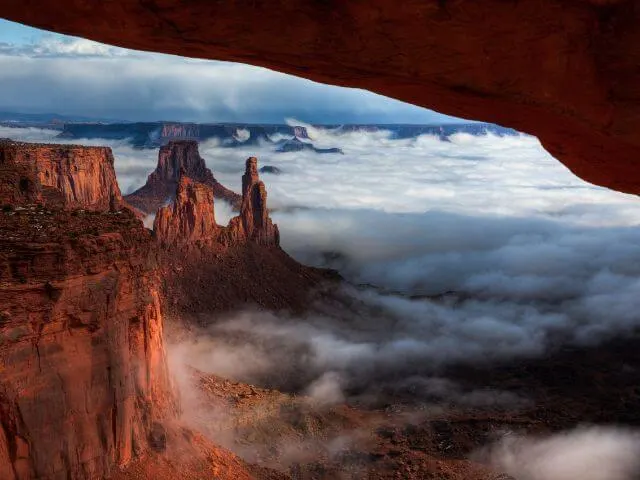 Driving Distance from Las Vegas: 470 miles (approx 7hrs)
Driving Distance from Las Vegas: 470 miles (approx 7hrs)
Year Established: 1964
Annual Visitors: 735,000
Best Time to Visit: March to May, September to November
Canyonlands National Park Highlights Hike Mesa Arch for sunrise, Hike Grand Viewpoint Overlook and the Needles, See Green River Overlook and Shafer Point Overlook, explore The Maze
Canyonlands National Park is a natural wonder located in southern Utah.
The park is known for its stunning canyons, mesas, and unique rock formations. One of the highlights of the park is the Island in the Sky, a large mesa that offers panoramic views of the surrounding canyons and the Colorado River. Visitors can also explore the Needles district, where they can find towering spires, and the Maze district, which is known for its challenging backcountry hiking.
The best time to visit Canyonlands National Park is during the fall or spring, when the weather is mild and the crowds are smaller. The park can get very hot during the summer, so it is best to plan your visit during the cooler months. The park also offers many great hiking trails, so make sure to wear appropriate footwear and bring plenty of water.
Yosemite National Park (California) – 7hrs 15 mins | 451 miles
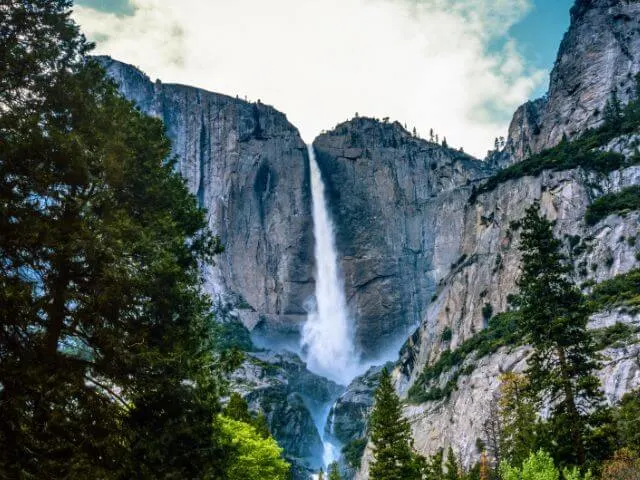 Driving Distance from Las Vegas: 451 miles (approx 7hr 15 mins)
Driving Distance from Las Vegas: 451 miles (approx 7hr 15 mins)
Year Established: 1890
Annual Visitors: 4.4 million
Best Time to Visit: June to October
Yosemite National Park Highlights: Hike Yosemite Falls and Half Dome, Watch the Sunset at Taft Point, See Bridalveil Falls, hike the Mist Trail to Vernal and Nevada Falls and Explore Yosemite Valley.
Yosemite National Park is located in the Sierra Nevada mountains in California and is known for its spectacular granite cliffs, waterfalls, and giant sequoia groves. The park was first protected in 1864 and is now one of the most popular national parks in the country, with over 4 million visitors annually.
The park is home to some of the most iconic landmarks in the United States, including Half Dome and El Capitan, which are popular spots for rock climbing. The park also offers a variety of outdoor activities such as hiking, camping, and backpacking, as well as scenic drives and ranger-led programs.
One of the best times to visit Yosemite National Park is during the spring and fall, when the crowds are smaller and the weather is mild. In the spring, wildflowers are in bloom and the waterfalls are at their peak flow. In the fall, the deciduous trees turn beautiful shades of orange and gold.
Visitors should also be aware that the park can be quite busy during the summer months, so it is best to plan ahead and make reservations for camping or lodging. Also, it is recommended to bring warm clothing as temperatures can drop significantly, even during the summer.
National Monuments, National Recreation Areas & State Parks Near Las Vegas
Old Las Vegas Mormon Fort State Historic Park – 22 mins | 7 miles
 Driving Distance from Las Vegas: 7 miles (approx 22 mins)
Driving Distance from Las Vegas: 7 miles (approx 22 mins)
Year Established: 1855
Old Las Vegas Mormon Fort State Historic Park Highlights: See the first settlement that eventually became Las Vegas.
The Old Mormon Fort Museum is a historic site located in downtown Las Vegas that is dedicated to preserving the history of the early Mormon settlers in the region. The museum is housed in a replica of the original fort that was built in the 1850s by the Mormon pioneers and features a variety of exhibits and displays that tell their story and their role in the development of Las Vegas.
The Old Mormon Fort Museum is a great destination for history buffs and anyone interested in learning about the early history of the city.
Red Rock Canyon National Recreation Area (Nevada) – 28 mins | 15 miles
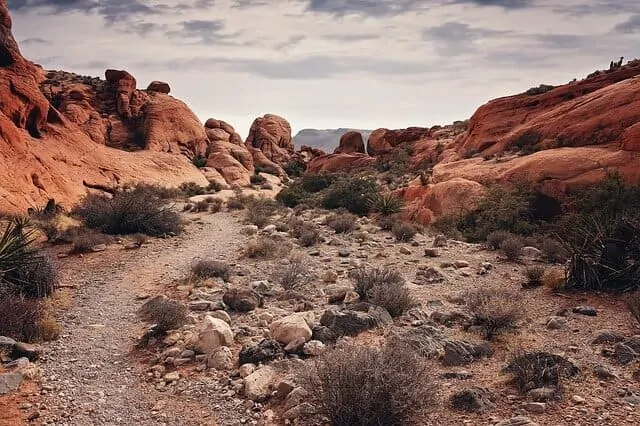 Driving Distance from Las Vegas: 15 miles (approx 28 mins)
Driving Distance from Las Vegas: 15 miles (approx 28 mins)
Year Established: 1990
Annual Visitors: 2 million
Best Time to Visit: September to May
Red Rock Canyon National Recreation Area Highlights: Calico Tanks Trail, Turtlehead Peak Trail, Ice Box Canyon Trail, Red Rock Overlook, Keystone Thrust Trail, Lost Creek Children’s Discovery Trail, La Madre Spring Trail, Pine Creek Canyon Trail, Sandstone Quarry Trail and Wilson Cliffs Trail.
Red Rock Canyon National Recreation Area is a breathtaking natural oasis situated just a short drive from the bustling city of Las Vegas, Nevada.
This iconic recreation area boasts towering red sandstone cliffs, rugged rock formations, and picturesque desert landscapes that capture the imagination of visitors from around the world. A highlight of the area is the scenic loop drive, offering captivating vistas of the vibrant desert scenery and stunning geological features.
Visitors can embark on exhilarating hikes along trails such as Calico Tanks and Turtlehead Peak, immersing themselves in the tranquil beauty of the Mojave Desert.
Red Rock Canyon is a haven for outdoor enthusiasts, offering opportunities for rock climbing, wildlife viewing, and serene picnics amidst the breathtaking surroundings.
The best time to explore Red Rock Canyon is during the cooler months of fall and spring, when the weather is mild and the desert landscape comes alive with color.
Hoover Dam & Lake Mead Recreation Area (Nevada) – 42 mins | 30 miles
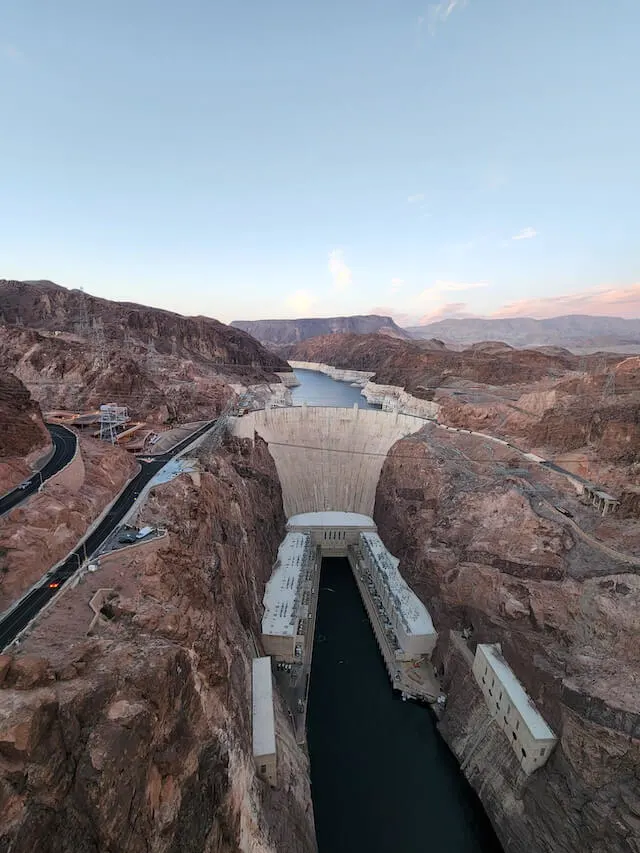 Driving Distance from Las Vegas: 30 miles (approx 42 mins)
Driving Distance from Las Vegas: 30 miles (approx 42 mins)
Hoover Dam Built: 20 April 1931 – 1 March 1936
Lake Mead Recreation Area Established: 13 October 1936
Annual Visitors: 7 million (Hoover Dam) + 5.6 million (Lake Mead)
Best Time to Visit: March to May, September to November
Hoover Dam and Leak Mead National Recreation Area Highlights: The Hoover Dam itself, cruise Lake Mead, Fish at Katherine Landing, Northshore Drive, Redstone Hiking Trail, Bike the River Mountains Bike Loop Trail, Railroad Trail and visit the Alan Bible Visitor Centre.
The Hoover Dam and Lake Mead National Recreation Area stand as monumental testaments to human ingenuity and the majestic power of nature.
Situated on the border between Nevada and Arizona, the Hoover Dam is an engineering marvel that harnesses the mighty Colorado River, providing hydroelectric power and water to millions of people across the southwestern United States.
Visitors to the dam can marvel at its imposing concrete structure, which rises dramatically from the depths of Black Canyon, and learn about its fascinating history and significance at the visitor center.
Just downstream from the dam lies Lake Mead, the largest reservoir in the United States, framed by rugged desert landscapes and towering cliffs. The Lake Mead National Recreation Area offers endless opportunities for outdoor adventure, from boating and fishing on the sparkling waters of the lake to exploring hidden coves and sandy beaches along its shoreline.
Visitors can also hike scenic trails, camp under the stars, and marvel at the breathtaking vistas that stretch as far as the eye can see.
Valley of Fire State Park (Nevada) – 55 mins | 55 miles
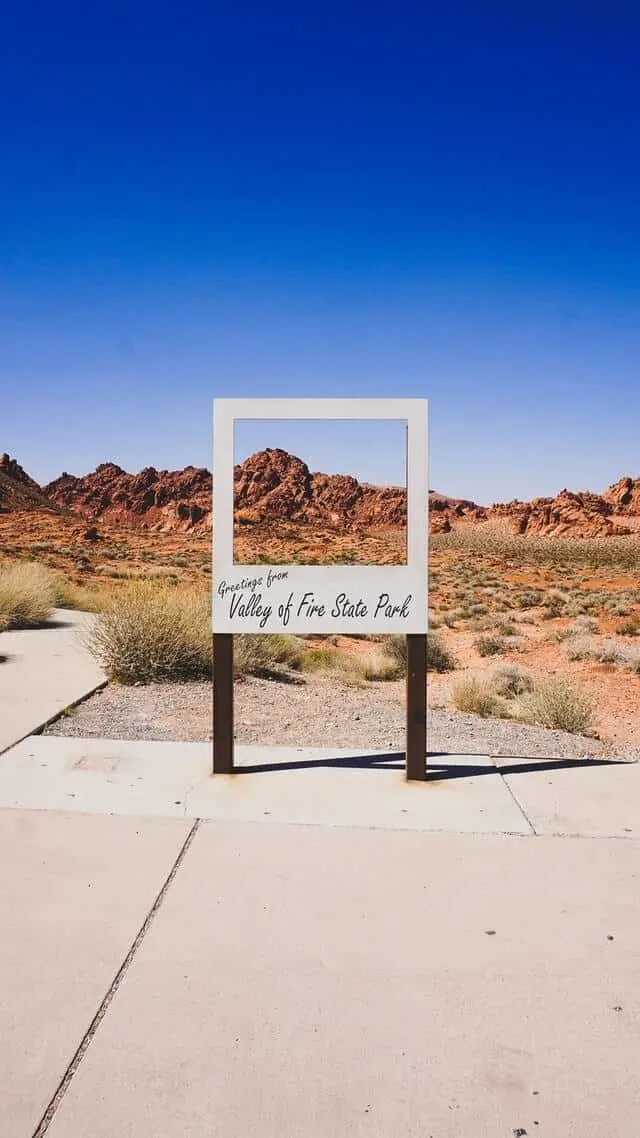 Driving Distance from Las Vegas: 50 miles (approx 55 mins)
Driving Distance from Las Vegas: 50 miles (approx 55 mins)
Year Established: 1935
Annual Visitors: 300,000+
Best Time to Visit: October to April
Valley of Fire State Park Highlights: ATV Rides, Beehives, Elephant Rock, First Wave, Fire Canyon Overlook, Pink Wave, Balanced Rock, Rainbow Vista Trail, Seven Sisters, Atlatl Rock, Arch Rock, Mouse’s Tank Road (The Scenic Drive).
Nestled within the vast expanse of the Mojave Desert, Valley of Fire State Park stands as a radiant jewel, ablaze with fiery sandstone formations and ancient petroglyphs etched into the rock by ancient civilizations.
Located just a short drive from Las Vegas, Nevada, this awe-inspiring landscape captivates visitors with its surreal beauty and otherworldly atmosphere. Aptly named for the vibrant red sandstone formations that seem to ignite with color under the desert sun, Valley of Fire is a playground for adventurers and nature enthusiasts alike.
Hikers can traverse winding trails that lead through narrow slot canyons, past towering rock arches, and alongside towering monoliths that seem to defy gravity. At every turn, the landscape reveals ancient secrets, from the petrified logs of the Rainbow Vista to the mysterious rock formations of the Fire Wave.
As the sun sets, the fiery hues of the sandstone cliffs deepen, casting a warm glow over the desert landscape and illuminating the ancient petroglyphs that adorn the canyon walls. Be there for sunset for one of the best sunsets you’ll ever see.
Mojave National Preserve – 1hr 3 mins | 68 miles
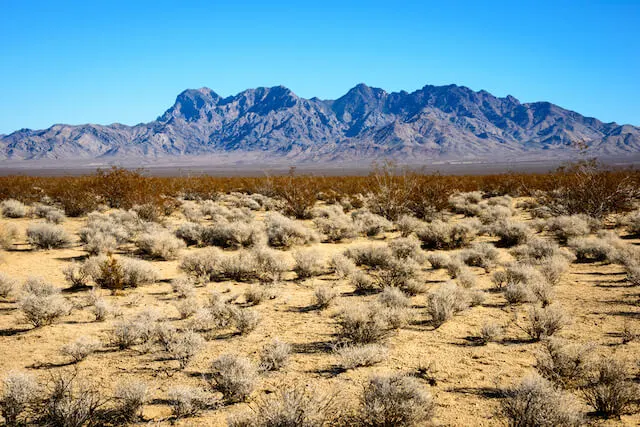 Driving Distance from Las Vegas: 68 miles (approx 1hr 3 mins)
Driving Distance from Las Vegas: 68 miles (approx 1hr 3 mins)
Year Established: 31 October 1994
Annual Visitors: 866,635
Best Time to Visit: February to April
Mojave National Preserve Highlights: See the Joshua Trees, The Mojave Memorial Cross, Lava Tubes Tral, Teutonia Peak Trail, Banshee Canyon, Kelso Dunes, Boulders Viewpoint, Cinder Cones. Visit ZZYZX.
Nestled amidst the vast expanse of the Mojave Desert, Mojave National Preserve stands as a rugged and captivating testament to the raw beauty of the American Southwest.
Spanning over 1.6 million acres of diverse desert landscapes, this pristine wilderness offers a sanctuary for those seeking solace amidst the untamed beauty of the desert. Towering Joshua trees stand sentinel amidst vast stretches of golden sand dunes, while ancient lava flows and rugged mountain ranges carve out a landscape of breathtaking contrasts.
As the sun sets over the desert horizon, casting its warm glow upon the rugged terrain, Mojave National Preserve comes alive with a vibrant display of color and light, a symphony of nature’s wonders that captivates the soul.
Exploring Mojave National Preserve is a journey through time and space, where each twist and turn reveals a new vista of natural beauty and cultural significance. From the iconic Joshua Tree Forest (there are more of them here than anywhere else on earth!) to the majestic Kelso Dunes, the preserve offers endless opportunities for exploration and discovery, from hiking and camping to wildlife watching and stargazing beneath the desert sky.
Antelope Canyon & Horseshoe Bend (Najavo Nation – Arizona) – 4hr 30 mins | 280 miles
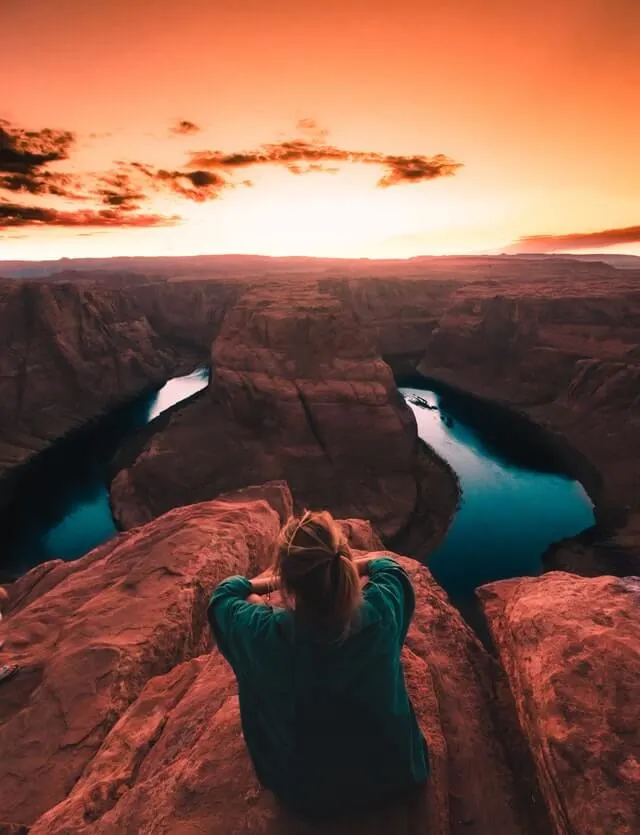 Driving Distance from Las Vegas: 280 miles (approx 4hr 30 mins)
Driving Distance from Las Vegas: 280 miles (approx 4hr 30 mins)
Year Established: Both were created by nature over millions of years
Annual Visitors: 3 million combined (2 million, Horseshoe Bend; 1 million, Antelope Canyon Navajo National Park)
Best Time to Visit: November to July
Horseshoe Bend & Antelope Canyon Highlights: Horseshoe Bend at Sunset, Upper Antelope Canyon
Nestled within the rugged terrain of the Glen Canyon National Recreation Area, Horseshoe Bend and Antelope Canyon stand as iconic marvels of nature’s artistry, drawing travelers from around the world to witness their breathtaking beauty.
Horseshoe Bend, carved by the meandering waters of the Colorado River, reveals a stunning horseshoe-shaped curve that plunges dramatically into the depths of Glen Canyon, offering panoramic vistas that defy imagination.
As the sun sets, the sandstone cliffs ignite with hues of red and gold, casting a warm glow over the swirling waters below, creating a spectacle of light and shadow you don’t want to miss.
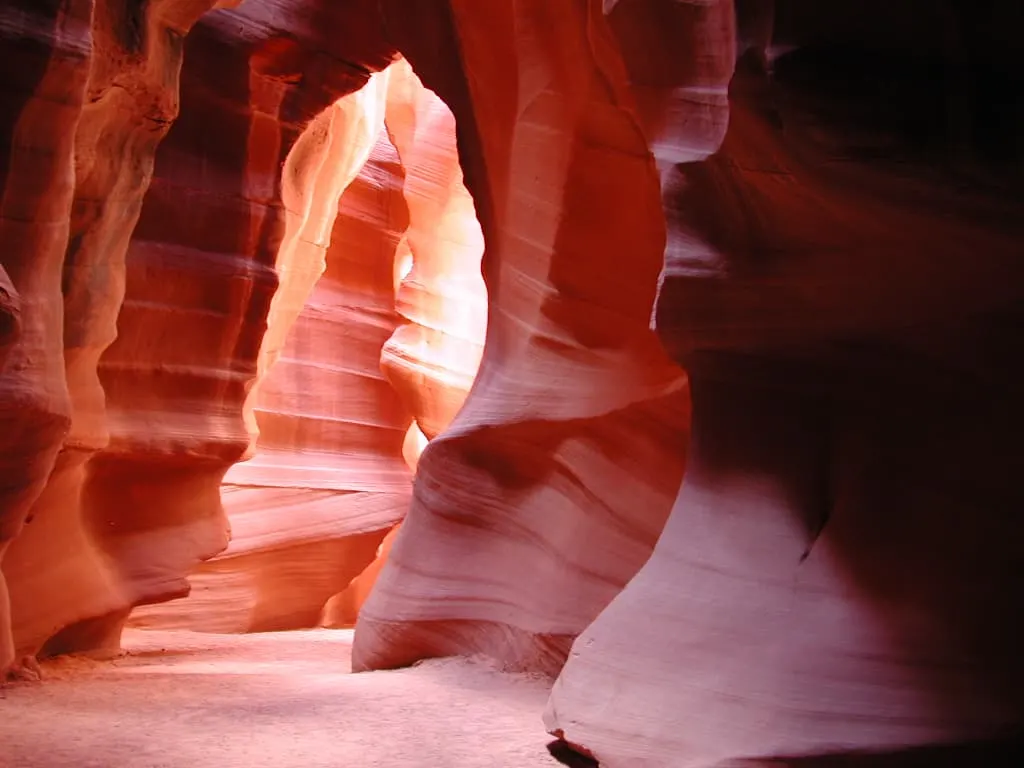 Adjacent to Horseshoe Bend lies Antelope Canyon, a slot canyon sculpted by millennia of wind and water erosion, revealing sinuous corridors of sculpted sandstone that twist and turn with graceful curves and ethereal light.
Adjacent to Horseshoe Bend lies Antelope Canyon, a slot canyon sculpted by millennia of wind and water erosion, revealing sinuous corridors of sculpted sandstone that twist and turn with graceful curves and ethereal light.
As sunlight filters through the narrow openings above, shafts of light dance upon the canyon walls, illuminating vibrant hues of orange, pink, and purple, creating an otherworldly spectacle that transports visitors to a realm of wonder and awe.
Exploring the labyrinthine passages of Antelope Canyon is a journey through time and space, where each twist and turn reveals a new vista of natural beauty, inviting travelers to immerse themselves in the timeless splendor of the desert landscape.
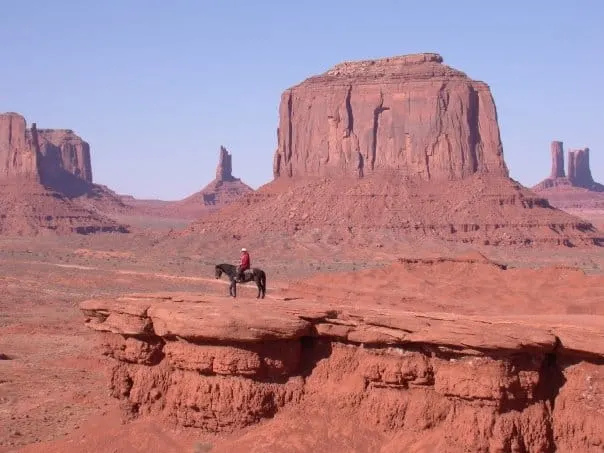 Driving Distance from Las Vegas: 399 miles (approx 6hr 23 mins)
Driving Distance from Las Vegas: 399 miles (approx 6hr 23 mins)
Year Established: 1958
Annual Visitors: 350,000+
Best Time to Visit: March to May, September to November
Monument Valley Highlights: Take a guided tour with a Navajo Guide, drive the scenic loop, See the Mittens, Camel Butte, Elephant Butte, Three Sisters, and Totem Pole formations, Stand at John Ford Point, Tour Hogan Village & Stand Under the Great Hogan Arch, Ear of the Wind.
Nestled within the vast expanses of the American Southwest, Monument Valley stands as a sacred sanctuary of timeless beauty and cultural significance.
In the native language, Monument Valley is called ‘Tse Bii’Ndzisgaii” and means Valley of the Rocks. As such, this iconic landscape is characterized by its towering sandstone buttes and sweeping vistas and has captured the imagination of travelers and artists for generations, evoking a sense of wonder and reverence for the natural world.
As the sun rises over the horizon, casting its golden light upon the ancient rock formations, Monument Valley awakens to reveal its majestic splendor, a symphony of color and texture that unfolds beneath the vast desert sky. Learn about the spiritual significance of each formation on a guided tour and stay for sunset for an incredible light show.
Extra: While you’re in the area, we would highly recommend taking a 90-minute detour to the Four Corners Monument, a fun spot where you can place a body part in 4 different states, where Arizona, Colorado, New Mexico, and Utah meet.
With so many incredible National Parks near Las Vegas it can be a little overwhelming, but we hope our complete guide to the National Parks nearby to Las Vegas has helped you narrow down which ones you want to tick off your National Park Bucket List first!
We hope our National Parks near Las Vegas Map had been a huge help in planning your adventures, and if you know of anyone else who needs a little bit of inspiration or assistance in planning their National Parks trip, please be sure to share on social media: Facebook, Flipboard, Twitter or grab an image from below for Pinterest. And remember – sharing is caring (and we thank you in advance!)

READY FOR MORE USA TRAVEL INSPIRATION? YOU MIGHT BE INTERESTED IN THESE TRAVEL TIPS, TRAVEL ARTICLES, DESTINATION GUIDES, TRAVELER RESOURCES, AND RELATED POSTS ABOUT OTHER AMAZING CITIES IN NORTH AMERICA:
- Chicago: An Awesome Weekend in Chicago – Things to do, Where to Stay & What to eat!
- Los Angeles: An Incredible Weekend Getaway in Los Angeles
- Dallas: Everything’s bigger in Texas and Dallas & Dallas Fort Worth are no exception!
- Portland: 10 Fun Things to do in Portland Oregon + Day Trips from Portland
- Cincinnati: Things to do in Cincinnati & Day Trip Ideas
Hi There! Thanks for reading about the 13 National Parks near Las Vegas Nevada Travel Guide – I just wanted to let you know that this post contains affiliate links, which means if you purchase something after clicking a link, I may get a small commission – which is at absolutely no cost to you. If you enjoyed this article and are going to be searching for some of the things I mention anyway, I would love it if you could click through from the links above & thank you in advance! Read my full Disclosure here.
And a huge Thank You for reading the MakeTimeToSeeTheWorld travel blog.
